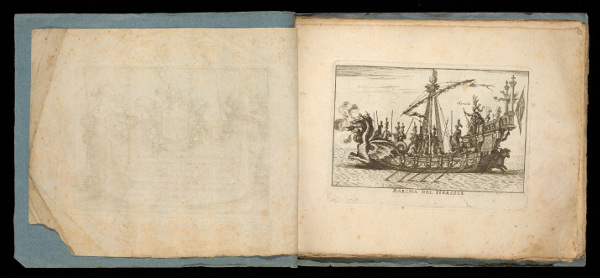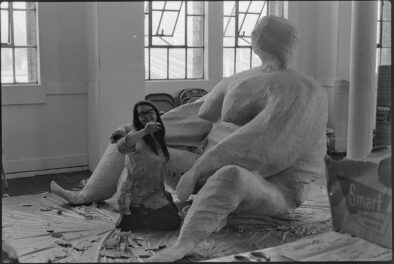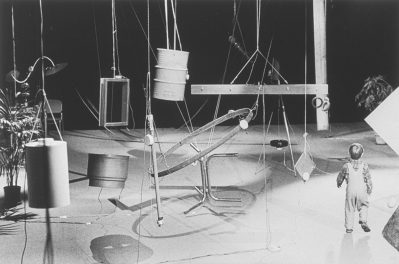Elizabeth E. Roth worked at the New York Public Library from 1944 until her retirement in 1981, serving as Keeper of Prints, Rare Books, and of the Spencer Collection. She developed a keen interest in festival books—lavishly illustrated objects documenting elaborate religious, civic, and courtly events.
The Getty Research Institute holds the Elizabeth Roth Research Papers on Festivals, a trove of materials documenting Roth’s foundational studies on festivals held in France, Germany, Italy, the Netherlands, the United States, and other countries from 1484 to 1918. The finding aid for this archive recently became available online.
A Bibliophile
Born and raised in Switzerland, in 1939 Roth moved to the United States, where she pursued her graduate studies at the University of Minnesota. Upon graduation, Roth started working at the New York Public Library (NYPL) and, in 1947, was offered a position in the Department of Prints. Roth was the first assistant to Karl Kup, who for three decades served as the NYPL’s Keeper of Prints, the chief of the Art and Architecture Division, and the curator of the Spencer Collection of illustrated books, manuscripts, and fine bindings. When Kup retired, Roth took over his duties and was appointed Keeper of Prints and the Spencer Collection in 1969.
In addition to being a member of the Cosmopolitan Club, Roth belonged to the Hroswitha Women Book Collectors Club. Many prominent female book collectors, such as Mary Hyde, joined this society before the male-only Grolier Club allowed women into its ranks.
Roth’s Project for a Bibliography on Festival Books
After retiring in 1981, Roth divided her time between Zurich and New York, where curator Janet Byrne invited her to pursue independent research at the Metropolitan Museum of Art. At the suggestion of Kup, Roth decided to focus on festival books. There was no comprehensive bibliography of European festival books at the time, so Roth set out to create one.
To compile this annotated bibliography, Roth not only investigated the Spencer Collection’s rich holdings of festival books, but also those of the Metropolitan Museum of Art, Pierpont Morgan Library, Kunstbibliothek of the Staatliche Museen zu Berlin, Zentralbibliothek in Zurich, the library of Paul Gourary, and several other institutional and private collections.
Her research papers include card catalogs, auction catalog clippings, dealers’ catalogs, articles, conference papers, bibliographic references, and correspondence. The bulk of the archive contains notebooks of draft entries for the final annotated bibliography. The Getty Research Institute has its own extensive collection of festivals books, making Roth’s research papers a particularly valuable resource for visiting scholars and illustrated book enthusiasts.

Plate 36 from a scroll commemorating the coronation of Charles V in Bologna on February 24, 1530. The celebrations included a feast for the people of Bologna, depicted here with crowds gathered around an arch decorated with the double-headed Imperial eagle and two gilt lions spouting white and red wine. (Aquila Intermedios Leones Vinum Album Et Rubrum Fundentes, 1530, Nikolas Hogenberg and Eugen Bruining. The Getty Research Institute, P910002)

This bound suite of prints includes a title leaf and 18 etchings depicting a mock naval battle performed on the Arno River in Florence on November 3, 1608, in celebration of the wedding of Cosimo II, Duke of Tuscany, to Maria Maddalena of Austria. (Le manifique carousel fait sur le fleuue de l’Arne a Florence, pour le mariage du grand duc, 1664, Nicolas François Bocquet. The Getty Research Institute, 2003.PR.73)

This print shows the design for a fireworks display that was scheduled to take place on June 22, 1763, near the Place Louis XV in Paris; the event was in celebration of the treaties marking the end of the Seven Years’ War. The display features a façade elevated on a rocky island on the Seine and topped with an equestrian statue placed under a slender arch. Palm trees, exotic animals, putti, and allegorical figures appear among the rocks, while spectators are gathered on the shore. (Vue perspective du feu d’artifice qui doit etre tire sur l’eeau pres la place de Louis XV en rejouissance de la paix le vingt deux juin, Paris, ca. 1763. The Getty Research Institute, 2000.PR.22)
The Elizabeth Roth Research Papers on Festivals are available for study by qualified researchers at the Research Library of the Getty Research Institute. Visit the Research Library’s online page for its Festival Collection and its research guide.
For further information on the Festival Collection, also visit the Research Library’s online catalog and combine the keyword “festivals” with names of cities, such as Paris, Rome or Madrid or combine the keyword “festivals” with the names of rulers, such as “Louis XIV,” or with the names of artists, such as Bernini. For types of festivals, search the online catalog using keywords, such as Cuccagna or processions. The search results can be delimited to GRI Special Collections and to collections that have been digitized (“Available Online”).

See all posts in this series »





Comments on this post are now closed.